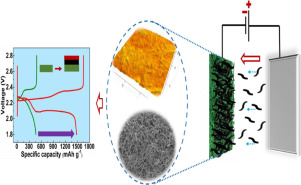Journal of Energy Chemistry ( IF 14.0 ) Pub Date : 2019-12-28 , DOI: 10.1016/j.jechem.2019.12.015 Sasan Ghashghaie , Samson Ho-Sum Cheng , Jie Fang , Hafiz Khurram Shahzad , Robin Lok-Wang Ma , Chi-Yuen Chung

|
In the present study, the electrophoretic deposition method was successfully applied as a binder-free and scalable approach to deposit carbonaceous nanomaterials on carbon fiber paper (CFP) for cathode applications in Li–S batteries. The microstructural studies of the EPD-CNT film using scanning electron microscopy (SEM) revealed the formation of a crack-free and porous layer of CNTs being uniformly distributed on the CFP surface. The EPD:CFP/CNT/S cathode delivered a capacity around 2.2 times higher than that obtained in the absence of the EPD-CNT film (CFP/S cell) after 50 cycles and a capacity of 935 mAh g−1 after 100 cycles at 0.1 C. The EPD method was then employed to fabricate layer-by-layer structures where the EPD-CNT film was decorated with carbon black particles. The initial capacity as well as the reversible capacity after 100 cycles was further increased by the EPD:CFP/CNT/KB/S layer-by-layer structure to 1473 and 1033 mAh g−1, respectively, indicating effective suppression of the shuttle effect. In addition, the rate performance of CFP/S was improved by depositing the EPD-CNT and EPD-CNT/carbon black architectures on CFP surface, and even further enhanced through the co-deposition of CNT and Pt nanoparticles by EPD, delivering a specific capacity of around 730 mAh g−1 at 1 C. Finally, the cathodes fabricated by EPD were observed to outperform those made by the conventional casting method in terms of cycling performance, internal resistance, and polarization. This difference was ascribed to the non-uniform microstructure of the Cast-CNT film, which resulted in poor interfacial connection between the CNT agglomerates, hindering uniform sulfide/sulfur deposition during cycling. The obtained results suggested that the binder-free C/S nanocomposite cathode made by EPD is key to further enhance the specific capacity and energy density of Li–S batteries.
中文翻译:

电泳沉积的无粘结剂3-D碳/硫纳米复合阴极,用于高性能Li–S电池
在本研究中,电泳沉积方法已成功地用作无粘合剂且可扩展的方法,用于在碳纤维纸(CFP)上沉积含碳纳米材料,以用于Li-S电池的阴极应用。使用扫描电子显微镜(SEM)对EPD-CNT膜进行的微结构研究表明,形成了无裂纹且多孔的CNT层,均匀地分布在CFP表面。经过50个循环后,EPD:CFP / CNT / S阴极的容量比不使用EPD-CNT膜(CFP / S电池)时的容量高约2.2倍,容量为935 mAh g -1在0.1 C下100个循环后,EPD方法被用来制造层状结构,其中EPD-CNT膜上装饰有炭黑颗粒。EPD:CFP / CNT / KB / S的逐层结构进一步提高了100次循环后的初始容量和可逆容量,分别达到1473和1033 mAh g -1,表明有效抑制了穿梭效应。此外,通过在CFP表面沉积EPD-CNT和EPD-CNT /炭黑结构,改善了CFP / S的速率性能,并且通过EPD共沉积CNT和Pt纳米颗粒,进一步提高了CFP / S的速率性能,约730 mAh g -1的容量最后,在循环性能,内部电阻和极化方面,观察到由EPD制成的阴极性能优于传统浇铸方法制成的阴极。这种差异归因于Cast-CNT膜的不均匀微观结构,这导致CNT附聚物之间的界面连接不良,从而阻碍了循环过程中硫化物/硫的均匀沉积。所得结果表明,EPD生产的无粘结剂C / S纳米复合阴极是进一步提高Li-S电池的比容量和能量密度的关键。









































 京公网安备 11010802027423号
京公网安备 11010802027423号